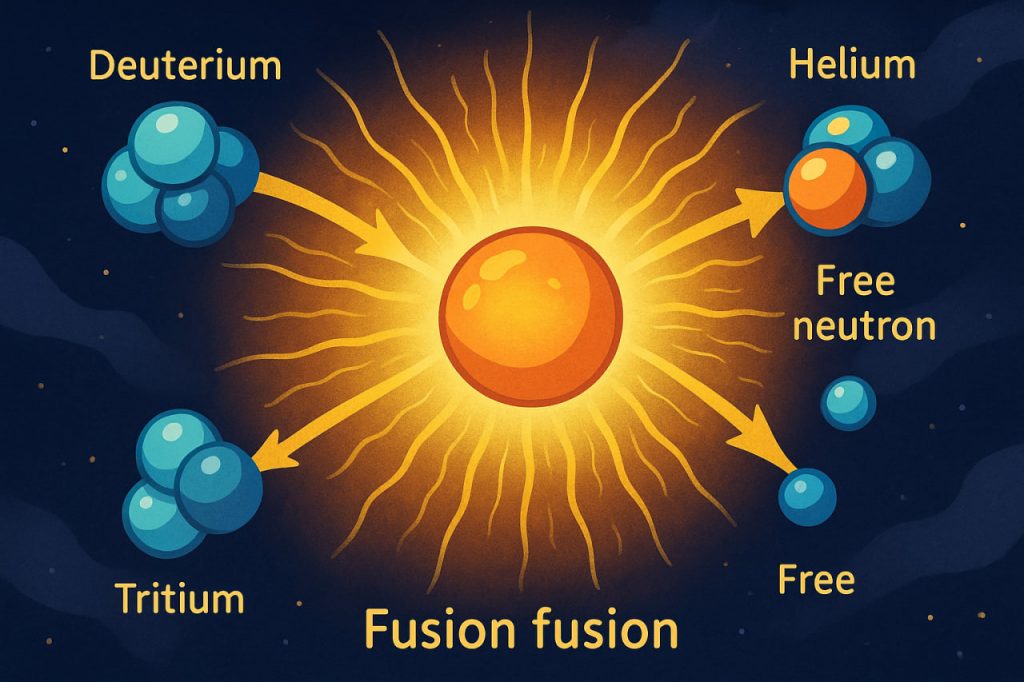Nuclear fusion is the process by which two light atomic nuclei combine to form a heavier nucleus, releasing an enormous amount of energy in the process. It is the same reaction that powers the Sun and other stars. Unlike nuclear fission, which splits atoms and is used in current nuclear power plants, fusion combines atoms — and produces less radioactive waste, no greenhouse gases, and offers a virtually limitless source of clean energy. For decades, scientists have pursued controlled nuclear fusion on Earth as a potential energy revolution.
The Physics Behind Fusion
Fusion occurs when two nuclei get close enough for the strong nuclear force to overcome their electrostatic repulsion (since both nuclei are positively charged). This requires extremely high temperatures and pressure, like those in the Sun’s core — over 15 million degrees Celsius.
In stars, hydrogen nuclei (protons) fuse to form helium, releasing energy in the form of light and heat. On Earth, scientists often use isotopes of hydrogen — deuterium and tritium — because they fuse more easily under laboratory conditions and release more energy.
Why Fusion Is So Promising
Fusion has several powerful advantages over other forms of energy:
- Fuel is abundant: Deuterium is found in seawater, and tritium can be bred from lithium.
- No carbon emissions: Fusion doesn’t produce CO₂ or contribute to climate change.
- Minimal radioactive waste: Unlike fission, it produces no long-lived radioactive byproducts.
- No meltdown risk: If something goes wrong, the reaction naturally stops — it can’t “explode”.
These features make fusion one of the most sought-after solutions for sustainable, large-scale energy.
Fusion Conditions: Hot, Dense, and Confined
To achieve fusion on Earth, three key conditions must be met:
- High temperature – Over 100 million degrees Celsius.
- Sufficient pressure (density) – To increase collision chances.
- Confinement time – To keep particles together long enough to fuse.
There are two main ways to confine the superhot plasma where fusion occurs:
- Magnetic confinement (e.g. in a tokamak): Uses magnetic fields to trap the plasma inside a donut-shaped chamber.
- Inertial confinement (e.g. lasers): Uses lasers or ion beams to compress a tiny pellet of fuel rapidly and cause fusion.
Modern Fusion Research and Breakthroughs
Several international and national projects are working toward practical fusion energy:
- ITER (France): The largest tokamak under construction, supported by over 30 countries. It aims to produce more energy than it consumes.
- NIF (USA): The National Ignition Facility uses powerful lasers to achieve fusion ignition.
- SPARC (USA) and JET (UK): Experimental reactors pushing the limits of magnetic confinement.
- Private startups: Companies like Helion, TAE Technologies, and General Fusion are exploring compact, innovative reactor designs.
In 2022, scientists achieved a net energy gain in a fusion reaction for the first time — a major step toward commercialization.
Challenges Ahead
Despite progress, several obstacles remain:
- Material durability: Reactor walls must withstand extreme heat and neutron bombardment.
- Energy balance: Creating and sustaining the fusion reaction still consumes a lot of energy.
- Economic viability: Scaling fusion to produce electricity affordably remains a major hurdle.
However, with continued investment and global cooperation, many experts believe fusion power could become a reality by the 2030s or 2040s.
Glossary
- Nuclear fusion: The process of combining light atomic nuclei to form a heavier nucleus, releasing energy.
- Deuterium: A stable isotope of hydrogen with one proton and one neutron.
- Tritium: A radioactive isotope of hydrogen with one proton and two neutrons.
- Plasma: A hot, ionized gas where electrons are separated from nuclei.
- Tokamak: A device using magnetic fields to confine plasma in a donut shape.
- Ignition: The point at which a fusion reaction produces more energy than is needed to start it.
- Strong nuclear force: The fundamental force that binds protons and neutrons inside atomic nuclei.


